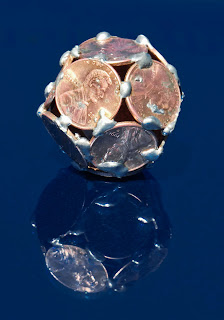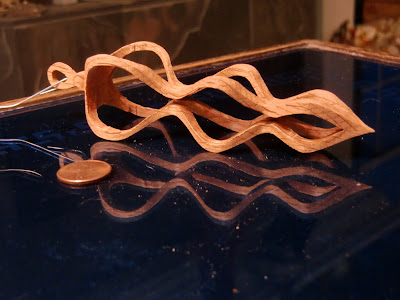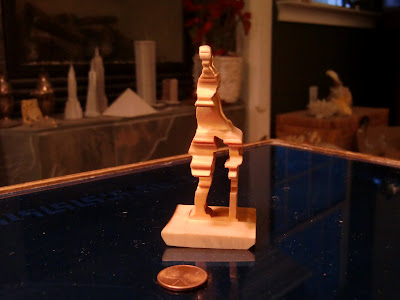Platonic and Archimedean Solids from Coins
That's why I call this Five Dollars and Twelve Cents.
Tuesday, July 05, 2011 | | 0 Comments
Dymaxion World: Cubeoctahedron Globe
I've always been interested in maps and different projections and how they make such a difference in the way the world looks when a sphere is projected onto a flat surface. Yesterday my wife sent me this link to an issue of Life Magazine from March 1, 1943. On page 41 of this issue they discuss a new (at the time) projection from Buckminster Fuller, a famous inventor who is now most well-known for his geodesic spheres and houses made out of them. This projection is called The Dymaxion World, and can be folded up to form a geometric object known as a Cubeoctahedron. While the point of the projection is to have a flat-map with desirable properties such as low distortion and the ability to have all of the landmasses contiguous, I just think it looks cool folded up to form a bizzare globe. Note: Fuller eventually decided on another polyhedron, the icosahedron, to use for The Dymaxion World. It is a much "rounder" shape that actually looks like a globe. I've made those before and I don't think they look nearly as cool.
The images of the templates at the very bottom of this post, obtained from the original article, are high enough resolution to make about a 10 inch globe on standard paper if you click on the pictures and download the higher resolution version. I used thick cardstock, and a tacky glue to construct mine. All you have to do is glue Tab A to Tab A, Tab B to Tab B, Tab C to Tab C...
Here's a picture of the one I built:
Finally the templates:
Saturday, May 21, 2011 | Labels: geometry, papercraft | 4 Comments
Standardized Testing And Reporting
It's the middle of April and this next week all students at University Preparatory School, where I teach, will be taking the California standardized tests. So I decided to design and build a sculpture that I'm calling "Standardized Testing And Reporting" or "STAR", which is what the California testing program is named. The sculpture is made up of 80 pencils and is held together with a variety of glues.
Two of the five identical pieces it is made from:
The second was Carlo H. Séquin's Ribbed Hemicube. This brought the realization that you could easily embed hyperbolic paraboloids into regular tetrahedra. Here's my recreation of that work:
Sunday, April 10, 2011 | Labels: geometry, sculpture | 7 Comments
Epic "Stop Motion" Steady Cam Shot
You must watch this video! Then read the short story below. It looks really good if you click on the full screen icon right underneath the video between the HD symbol (already on) and the Vimeo logo.
Nice Shot! from Blownapart Studios on Vimeo.
Last weekend, I went down to Sacramento California to help out my brother Michael Poole and cousin Steve Bailey who are the creative forces behind Blown Apart Studios with a video shoot which was a lot of fun. They are putting together a Still Photography Tutorial DVD called Lighting Boot Camp with Mark Behrens. We were filming at Elk's Tower with a bunch of models and guns at a workshop called guns, guts and glory. I helped them shoot a special feature for the DVD which was a short action based movie which hopefully I can share soon once the editing is finished.
This was a shot that Steve made towards the end of the workshop. I'm going to quote their story on this shot here:
This is a single take steadicam shot during a photographic workshop at the Elk's Tower in Sacramento. The workshop put on by Mark Behrens and LookPW titled "Gun's Gut's and Glory" featured 22 photographers and 20 models. This shot actually came together completely unplanned, when most of the photographers and models had gathered into one room. It started out as a "wouldn't it be cool" and turned into an "alright everybody, listen up" in about 30 seconds. It took about 5 minutes to bring everyone up to speed, place people around the room, and figure out a rough path. The original shot is a little over two minutes long. The only editing we did was "speed ramping" which is basically just speeding up and slowing down the footage. It's obviously really hard to get 40 people to hold still for that long, so a lot of the sped up sections hide some of the movement. The other sped up and slowed down parts were just to emphasize it's epic awesomeness. Thanks to everyone who made this possible!
For more information visit: http://www.blownapartstudios.com/
Sunday, January 30, 2011 | Labels: photography, videography | 0 Comments
MC Escher Jigsaw Puzzle and Origamic Architecture Reconstruction
I've been a big fan of M.C. Escher's Art since I was a little kid. His impossible figures drawings are mindblowing and his tesselations are fantastic. In the last couple of months, I've actually done a couple of projects that involve his work.
The first I did on Thanksgiving break. I had become very interested in making jigsaw puzzles on my scroll saw and after doing a couple of interesting puzzles that I made by printing pictures I found online and gluing them to the piece to be cut, I decided that Escher's tesselations would make fantastic puzzles. The one I settled on making is called Mosaic II and is a very interesting piece that is made from 40 different animals that fit perfectly together. It is colored in such a way that dark pieces and light pieces only touch the other at "corners." For my version this isn't quite true because I left out the tongue of the snake because I didn't want it to be easy to break. It's a fun puzzle that takes people between a half hour and an hour if they have no prior knowledge of what the picture looks like.
The original Escher:
Initial outline cut on my scroll saw (The whole piece is about the size of a 8.5 x 11 sheet of paper):
Well I've never tried wood burning before...but hey it looks like fun. I used wood burning tips on my soldering iron.
A few hours later!
Even later....Wood burning is finished!
The Finished Product after about sanding, staining, and coating with polyeurethane. The total project was about 10 hours worth of work:
The second project I did in the morning of one of my days off during Christmas break. It's a paper version of Escher's Relativity that is cut and folded out of one piece of paper and stays together using only tabs and no glue. The technique is called Origamic Architecture and at some point I will probably put up a post on all the different pieces I've copied using this technique. I found the diagram for Relativity on a flikr and you can download it here. Note: my version is mirrored from both what the diagram suggests and the original Escher piece. I "decided" to fold it the other direction.
The original Escher drawing:
The piece I made by downloading the diagram, printing it on a piece of paper, and then cutting and folding as indicated.
What Escher's would look like if it was mirrored like mine:
Saturday, January 01, 2011 | Labels: papercraft, puzzles, sculpture, woodworking | 1 Comments
3D fractals cut on a scroll saw
This post is going to be on 3D fractals cut on a scroll saw. (Thus the title of course.) As some of you know, I'm somewhat addicted to making fractals, so it should be no surprise that a simple technique I learned ended up leading me to produce wooden fractals. Check out the paper craft fractals I've made here, and the worlds largest fractal made out of tortilla chips here,
To start this post, I'll put a couple of quick picture of the types of objects you can achieve with this technique, then I'll tell the whole story of how I started making them, and give a couple of tips, ideas and diagrams for people that want to try making them.
Quick Preview:
Over winter break, I've spent a lot of time using my scroll saw. I started out making Christmas Ornaments; I actually cut 10 different kinds of fretwork ornaments that I found diagrams for on the internet or in various scroll saw books and gave them as presents to all of my family. I probably made about 50 wooden ornaments in total by cutting up to 6 copies at a time.
Here's a small sample of the ornaments I made:
I also decided to try compound cutting 3 dimensional ornaments. This is standard scroll saw technique in which you cut on 2 different faces in order to produce a result. Here are pictures of the two that I made.
After cutting these compound ornaments out, I realized something. I was cutting out 4 different curves by only cutting two curves on each face. 2x2=4 of course... so why not try cutting 3 different curves on each face. This would give 3x3=9 curves. Hmmm... seems like exponential growth that could lead to an efficient method to produce fractal objects. So I started out trying to see what would happen if I cut out T-Square fractals on each of the 3 faces of a 1.5 inch cube that I made by taking a 2x2x48 Oak turning square (remember 2 inches is only 1.5 inches when you're buying most lumber). First I used the 2nd iteration of the T-Square which ends up getting you a cube, with 8 cubes at each corner, and then 7 cubes at each corner of those cubes for a total of 56 little cubes. This would take forever to carve by hand but probably less than an hour to cut using this scroll saw technique. I made the template by taking images from Wikipedia.
Here's a picture:
This one is looking at it so you only see one face letting you see what the diagram to cut it from would look like:
And here is the diagram it was cut from (You would fold along the red lines after scaling this to 3 inches by 3 inches) :
I needed to try to see if I could do iteration 3. This would mean that there would be 7 little cubes on each of the 56 small cubes from iteration 2 for a total of 392 really tiny cubes, some of which are fairly deep down in the structure. I failed on my first try, but succeeded on my second.
Here it is:
From there I decided to try a few ideas.
Here's a 3rd iteration Sierpinski square pyramid made by cutting 3rd iteration Sierpinski's triangles on 2 faces:
Here's a 2nd iteration Moore curve made by cutting 3 different faces using cross sections found from looking at pictures of a 3D Moore curve on Wolfram's mathworld site. Note to make this one you still have to cut a few pieces (10) by hand. But you get over 90% of the work done in an hour with the scroll saw. This is a really cool object. It is one continuous path connecting up the entire cube; a space filling curve.
Here's a fractal I made by making my own fractal tree and cutting it on two faces. Here it is looking at one face:
Now seeing it from a 45 degree angle:
Here's one made by cutting a square made out of quadratic type 1 Koch iteration 3 curves on 3 faces:
Here's another one made by cutting out nested circles on 2 faces and an x on the top. Note if you don't cut out the x on top you will be left with a very different object:
Here's a video of the object so you can see what it looks like when rotating:
A few non fractal objects:
On each of two faces this is five circles inside another circle. Small circles were made using a drill press.
Octagons on 3 faces:
Squares on three faces connected at their vertices instead of their faces (That would give a cube of course.) Here you get a rhombic dodecahedron which makes a fair twelve sided die.
This one is from a template. From one side it is a knight with armor, helmet, and sword:
From the other it is a griffin:
Here's a video showing it rotate:
Now for some tips.
1. You must make sure you're stock is square and when you cut them off you are making cubes with as flat of faces as possible.
2. Use clear tape (I use packing tape) to cover the wood. This makes the cutting easier by lubricating the blade as it cuts through the tape. (I'm really not sure how this works...but it does make a big difference)
3. Just glue the diagrams up to the material to be cut using a spray adhesive.
4. Cut along the lines...always doing any inside cuts first. After each cut is finished, you must put the material back and retape. This is an important step. This is what supports the piece and also what keeps the piece square to the table.
5. After every line is cut on all sides, remove all tape and carefully deconstruct. Somewhere in the middle is the object you want! :)
To create the diagrams, I've been finding images using either google image search or wikipedia. To make good geometrical diagrams, I also use geogebra which is a pretty cool free piece of software. I scale everything in photoshop.
Saturday, January 01, 2011 | Labels: fractals, geometry, sculpture, woodworking | 11 Comments
Popular Posts
-
This post is going to be on 3D fractals cut on a scroll saw. (Thus the title of course.) As some of you know, I'm somewhat addicted to...
-
I've been a big fan of M.C. Escher's Art since I was a little kid. His impossible figures drawings are mindblowing and his tesselat...
-
It's the middle of April and this next week all students at University Preparatory School , where I teach, will be taking the California...
-
I've always been interested in maps and different projections and how they make such a difference in the way the world looks when a sphe...
-
I ran across an article a couple of months ago talking about an artist making cityscapes using staples to build the buildings. The cities w...
-
A couple of weeks ago, I suddenly had the idea to make the Platonic solid s out of pennies. I'd made them before out of paper in severa...
-
I've been a big fan of George Hart's geometric sculptures for a while now and so a few weeks back I decided I would build his Frabjo...
-
This post combines two of my hobbies, making things out of paper (papercrafting) and exploring and building fractals. For those of you that...
-
I finally finished a papercraft project I've been working on for about a month. It's made up of parts of 29 sheets of cardstock. I...
-
I spent a little bit of time on the wooden orrery today. Click here for the original post and description . Two more sets of Gears are done...


































































